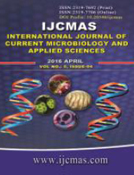


 National Academy of Agricultural Sciences (NAAS)
National Academy of Agricultural Sciences (NAAS)

|
PRINT ISSN : 2319-7692
Online ISSN : 2319-7706 Issues : 12 per year Publisher : Excellent Publishers Email : editorijcmas@gmail.com / submit@ijcmas.com Editor-in-chief: Dr.M.Prakash Index Copernicus ICV 2018: 95.39 NAAS RATING 2020: 5.38 |
A series of laboratory experiments were conducted at the Department of Plant Protection at the College of Agricultural studies- Sudan University of Science and Technology (Shambat). The objective of the study was to work out a management strategy for chickpea Cicer arietinum wilt disease caused by Fusarium oxysporum f. sp ciceri. The fungus was identified based on morphological and cultural characters as Fusarium oxysporum .In vitro studies were conducted to evaluate the effect of media, temperature and pH on mycelial growth of the fungus. The results showed that the fungus grew best on Potato Dextrose Agar medium (86.7 mm) followed by Potato Sucrose Agar (78.2 mm). Growth of F. oxysporum was maximum at 25 o C (84 mm) followed by 30 oC (46 mm). The maximum growth of the fungus was achieved at pH 7 followed by pH 6. The antifungal effects of the medicinal plant extracts Argel (Solenostemma argel), Ginger (Zingiber officinale) and Jatropha (Jatropha crucus) (seeds, stems, leaves and roots) were determined by in vitro study using aqueous and ethanolic extracts following the Poisoned Food Technique. The extracts, undiluted and 2and 4–fold diluted were screened for antifungal activity using PDA medium. All extracts gave significant inhibition of growth of the pathogen. Among all plants Argel extracts was the most inhibitory. It was followed in descending order by Ginger and Jatropha. Furthermore, the ethanolic extracts of all plants was more suppressive to the fungal growth than their aqueous equivalents. The fungicides, Bayfedan, Abronstar, and Thiram each at three concentrations (25, 50 and 100 ppm) reduced mycelial growth of the fungus in a concentration dependent manner. Thiram was the most effective (95% inhibition) followed in descending order by Bayfidan (82 % inhibition) and Abronstar (77% inhibition).
 |
 |
 |
 |
 |